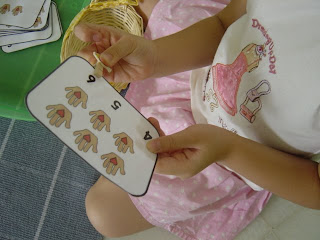Transferring activities are part of the Practical Life activities under the Montessori method. Transferring activities are important as they serve the indirect objectives of:- enhancing hand-eye coordination
- developing concentration and inner discipline
- strenghtening hand and finger muscles and movement
- developing the pincer grip - the way we hold a pencil properly
- preparing for reading and writing - both requires discipline, coordination and concentration
- developing patience
These are just the indirect objectives. In each of the transferring activities shown below, there are also direct objectives to be met. Each transferring activity is slightly different from the other, catering to different interests and age groups.
When preparing activities for the children to work on, it is imperative that the materials presented are aesthetically pleasing and attractive, the work must be challenging, yet achievable. My challenge this year would be to provide activities for different age groups - as the 5 and 6 year olds find some of the practical life activities BORING because they have done this and that already!
TRANSFERRING AND SORTING FRUITS
Let's look at the first activity below. This is the simplest form of transferring. It involves using a pair of tongs to transfer and sort the carrots and corns to two different containers. The direct objectives are to transfer and sort to different containers. May be simple, but to a 2 and 3 year old, sorting and matching are important skills for Maths later on.
The girl is only 2 and a half, but she has very good transferring skills and is able to work with the tongs effortlessly. She has very good fine motor skills. In the other transferring activities, she displayed the same skills, even though the other objects are relatively more difficult to handle.



TRANSFERRING GLASS PEBBLES INTO AN ICE-CUBE TRAY
The pebbles are more difficult to handle as they are smoother and heavier. However, this girl has no problems with this activity. She has very good pincer grip and I believe that if given a pencil, she would be able to colour or write effortlessly.
This activity is different from the above because it involves one-to-one correspondence. This means that they would be a pebble for each cube slot. Again, this is a vital Maths concept to grasp. Other examples include table setting for 1 person, 2 people, 4 people,etc. If I have 4 people for dinner, how many forks and spoons do I need?
I particularly like the glass pebbles because they resemble ice cubes. Don't they remind you of the nice glass of ice water?

TRANSFERRING CHERRIES ONTO A CONTAINER
I don't know how to describe the apple holder, but I saw it in shop and taught that it will make a beautiful addition to my shelf. In this activity, the child has to use the tongs and place the cherries carefully on each slot in the wooden apple.
This activity is more difficult as it involves very precise movement. The slots are small and are just able to hold the cherries, not much space to spare. I also want the child to put the stem facing up.
Another level of difficulty which I intend to introduce later is to use a pair of tweezers (instead of tongs) and let the child pinch the cherries by the stem and transfer them. Tweezers involve finer motor skills and are more difficult!


MAGNETIC TRANSFERRING
I thought that this activity will interest the older children. I found this beautiful steel chocolate mould at the same shop. Initially, I just wanted to do simple transferring and sorting with coloured counters. But, I just couldn't find any coloured counters on that day. Instead, I found these magnetics seeds and voila, this is even more interesting! The child gets to transfer, sort and discover about magnets at the same time!
While working with the little girl at this activity, I discovered that I did not prepare my control of error well. What do I mean? Control of error is important is many Montessori activities as they will help a child to work independently and to discover his/her mistakes by herself. In this case, the girl does not know where to put each coloured seed. Which cup is for which colour? She hesitated and I had to help her by putting in the first coloured seed in each slot.
So, I'll need to improvise by putting a colour guide (perhaps a sticker) at the outer rim of each cup for the children. See, that's why we learn together with the children at all times.


Transferring - there are many variations and these are just some of them. The more basic ones include transferring beans/rice with spoons from bowl to bowl, transferring into different sized containers. One which never fails to develop patience is transferring and sorting red and soya beans into different containers with a pair of tweezers. Try it if your child is overly active and cannot seem to focus!






































